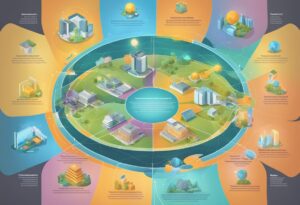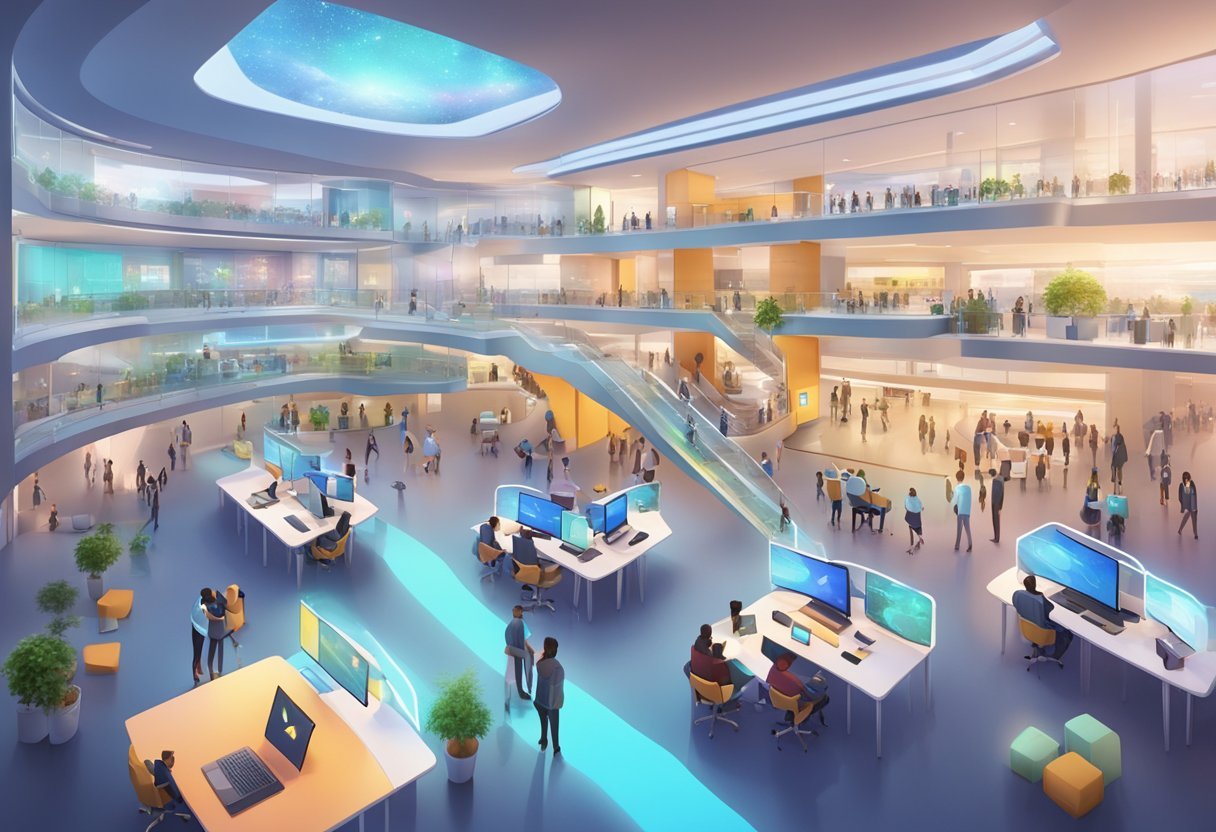Virtual reality is rapidly transforming the education sector, and the emergence of metaversities is a testament to this fact. A metaversity is a virtual reality campus that offers a metaverse experience in an educational setting. Unlike the general metaverse, which remains something of a theoretical concept, several metaversities are already up and running.
Metaversities are the next evolution beyond the immersive learning opportunities that currently exist for students at many colleges and universities. Higher education immersive learning experiences through virtual reality (VR), augmented reality (AR), and extended reality (XR) have exploded in the past few years, and metaversities represent the latest step in this evolution.
Evolution of Metaversities
Historical Context
The concept of virtual reality (VR) has been around for decades, with the first VR headset being developed in the 1960s. However, it wasn’t until the 1990s that the term “metaverse” was coined by science fiction author Neal Stephenson in his novel Snow Crash.
The metaverse was described as a virtual world where people could interact with each other in a three-dimensional space. This concept has since been expanded upon, with the development of digital twins and augmented reality (AR) technologies.
Technology Advancements
The advancement of technology has made it possible for metaversities to become a reality. Digital twins, which are virtual replicas of physical objects or environments, have been used to create virtual campuses for universities and colleges.
These digital twins are created using 3D scanning technology and can be accessed through VR and AR devices. This has allowed students to attend classes and interact with each other in a virtual environment.
The development of metaversities has also been made possible through advancements in VR and AR technologies. VR headsets have become more affordable and accessible, allowing more people to experience the benefits of virtual environments. AR technologies have also been used to create interactive learning experiences, where students can explore and interact with virtual objects in a real-world environment.
The evolution of metaversities has been made possible through the combination of historical context and technology advancements. The concept of the metaverse has been expanded upon, with the development of digital twins and AR technologies. This has allowed for the creation of virtual campuses, where students can attend classes and interact with each other in a virtual environment.
Metaversity Education Framework
Immersive Learning
Metaversities offer a unique opportunity for immersive learning that goes beyond traditional classroom settings. Students can engage with the material in a more interactive and engaging way, allowing for a deeper understanding of the subject matter.
Through the use of virtual and augmented reality technologies, students can explore and interact with complex concepts in a safe and controlled environment. This approach to learning can be especially beneficial for subjects that are difficult to grasp in a traditional classroom setting.
Digital Twin Campuses
Digital twin campuses are a key feature of metaversities. These digital replicas of real-world campuses allow students to navigate and explore the campus virtually.
This approach offers many benefits, including increased accessibility for students who may not be able to attend in-person classes. Digital twin campuses also allow for greater flexibility in scheduling and course offerings, as classes can be held in a virtual environment.
EngageVR Platform
The EngageVR platform is a powerful tool for metaversities. This platform allows for the creation and delivery of immersive educational experiences.
Using EngageVR, educators can create virtual classrooms, interactive simulations, and other educational content. This platform also allows for collaboration between students and educators, creating a more engaging and interactive learning experience.
Metaversities offer a unique and innovative approach to education. With immersive learning, digital twin campuses, and the EngageVR platform, students can engage with the material in new and exciting ways. As the metaverse continues to evolve, it is likely that metaversities will become an increasingly important part of the education landscape.
Key Institutions and Partnerships
Morehouse College
Morehouse College is one of the ten institutions selected to participate in the Meta’s metaversity pilot program. The college is partnering with VictoryXR, a company that specializes in creating immersive and interactive VR experiences, to develop its virtual campus.
Through this partnership, Morehouse College aims to provide students with a unique and engaging learning experience that is accessible from anywhere in the world. The virtual campus will offer students the opportunity to explore the campus, attend classes, and interact with faculty and peers in a virtual environment.
New Mexico State University
New Mexico State University is another institution that is participating in Meta’s metaversity pilot program. The university is partnering with VictoryXR to create a virtual campus that replicates its physical campus.
The virtual campus will allow students to attend classes, interact with faculty and peers, and explore the campus from anywhere in the world. The university aims to use this technology to enhance student learning and engagement, particularly for students who are unable to attend classes on campus.
University of Maryland Global Campus
The University of Maryland Global Campus (UMGC) is also partnering with Meta to develop its virtual campus. UMGC was one of the ten institutions selected to participate in the metaversity pilot program. The university aims to use this technology to provide students with a more immersive and engaging learning experience.
The virtual campus will offer students the opportunity to attend classes, interact with faculty and peers, and explore the campus in a virtual environment. Through this partnership, UMGC hopes to expand its reach and provide students with a more flexible and accessible learning experience.
These institutions have partnered with Meta and VictoryXR to create immersive and interactive virtual campuses that replicate their physical campuses. This technology aims to enhance student learning and engagement, particularly for students who are unable to attend classes on campus.

Technological Infrastructure
Virtual Reality Headsets
Metaversities rely heavily on virtual reality headsets to create immersive experiences for students. The most popular VR headset used in metaverse environments is the Quest 2 headset. It is a standalone device that allows users to experience virtual reality without the need for a computer or console.
The headset is equipped with two high-resolution displays and a powerful processor that enables smooth and realistic graphics. With the Quest 2, students can explore virtual campuses, attend virtual lectures, and interact with other students and professors in real-time.
Avatars and Interactivity
One of the key features of metaversities is the ability for students to create avatars that represent them in the virtual world. These avatars can be customized to look like the student and can be used to interact with other students and professors. Realistic interactivity is also a crucial aspect of metaversities.
Students can use their avatars to attend virtual lectures, participate in discussions, and collaborate on projects. The use of realistic interactivity in metaversities allows for a more engaging and interactive learning experience.
The technological infrastructure of metaversities is constantly evolving. Companies like Qualcomm are working on developing new technologies that will enhance the metaverse experience. As the technology continues to improve, metaversities will become even more immersive and realistic, providing students with a unique and engaging learning experience.
Challenges and Considerations
Privacy and Data Security
As metaversities continue to grow, privacy and data security issues become more prevalent. Biometric data, which is used to increase the immersive experience of the metaverse, raises serious privacy concerns. Theft and bullying are issues that cross from physical spaces to the metaverse. Therefore, it is crucial to implement security measures to protect the privacy and security of students.
Cost Implications
One of the significant advantages of metaversities is that they provide low-cost learning alternatives in some settings. However, there are significant costs and time implications associated with building and maintaining the metaverse.
For instance, building a cadaver laboratory costs several million dollars and requires a lot of space and maintenance. In contrast, a virtual cadaver lab has made scientific learning affordable at Fisk University. Therefore, it is crucial to consider the cost implications of implementing metaversities.
Accessibility and Inclusivity
Metaversities have the potential to provide access to education for faraway students who may not have had the opportunity to attend a traditional university. However, accessibility and inclusivity issues must be considered. For instance, students with disabilities may face accessibility challenges in the metaverse.
Therefore, it is crucial to ensure that metaversities are accessible and inclusive to all students, regardless of their physical or mental abilities.
Metaversities have the potential to revolutionize the education sector. However, privacy and data security, cost implications, and accessibility and inclusivity issues must be considered to ensure that metaversities provide a safe, affordable, and inclusive learning environment for all students.
Frequently Asked Questions
What educational experiences do metaversities offer compared to traditional universities?
Metaversities offer students a unique learning experience that is not possible in traditional universities. Students can interact with digital twins of universities in a virtual environment, which allows for 3D visual learning, more realistic interactivity, and easier access for faraway students.
Metaversities can also be customized based on students’ and institutions’ preferences, enabling a more personalized learning experience. Furthermore, metaversities can offer a range of courses and programs that are not available in traditional universities, such as virtual reality programming and design.
How does virtual reality technology integrate with homeschooling through metaversities?
Metaversities can provide homeschooling students with access to high-quality education that was previously unavailable to them.
Virtual reality technology can be used to create immersive educational experiences that allow students to interact with digital twins of universities and learn in a more engaging and interactive way. Homeschooling students can also benefit from the personalized learning experiences that metaversities offer, as courses and programs can be tailored to their individual needs and preferences.
What are the career opportunities associated with metaversity platforms?
Metaversity platforms offer a range of career opportunities for individuals with expertise in virtual reality technology, programming, and design.
As more metaversities are formed, there will be a growing demand for professionals who can create and maintain these digital environments. Metaversities can offer students the opportunity to gain practical experience in virtual reality technology and design, which can be valuable in a range of industries.
How do public perceptions of higher education influence the adoption of metaversities?
Public perceptions of higher education can play a significant role in the adoption of metaversities. While some individuals may be hesitant to embrace this new form of education, others may see it as an opportunity to expand access to high-quality education and create a more personalized learning experience. As more metaversities are formed and their benefits become more widely known, public perceptions of this new form of education may shift.
Can you describe the role of companies like VictoryXR in the development of metaversities?
Companies like VictoryXR play a crucial role in the development of metaversities. These companies specialize in creating immersive educational experiences using virtual reality technology, which can be used to enhance the learning experience in metaversities. VictoryXR and other companies like it can provide the expertise and resources necessary to create high-quality digital twins of universities and develop innovative educational programs.
What are the potential benefits and challenges of a metaverse campus for students and educators?
Metaverse campuses offer a range of potential benefits, including expanded access to high-quality education, a more personalized learning experience, and the opportunity to gain practical experience in virtual reality technology and design.
However, there are also potential challenges associated with this new form of education, such as the need for reliable technology and infrastructure, concerns about privacy and security, and the need for ongoing training and support for educators. As metaversities continue to evolve, it will be important to address these challenges and ensure that they do not hinder the growth and development of this innovative new form of education.




